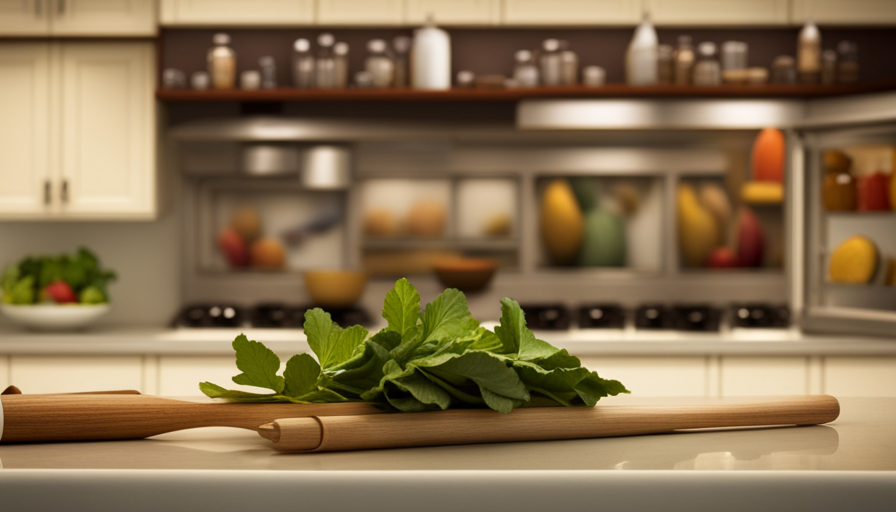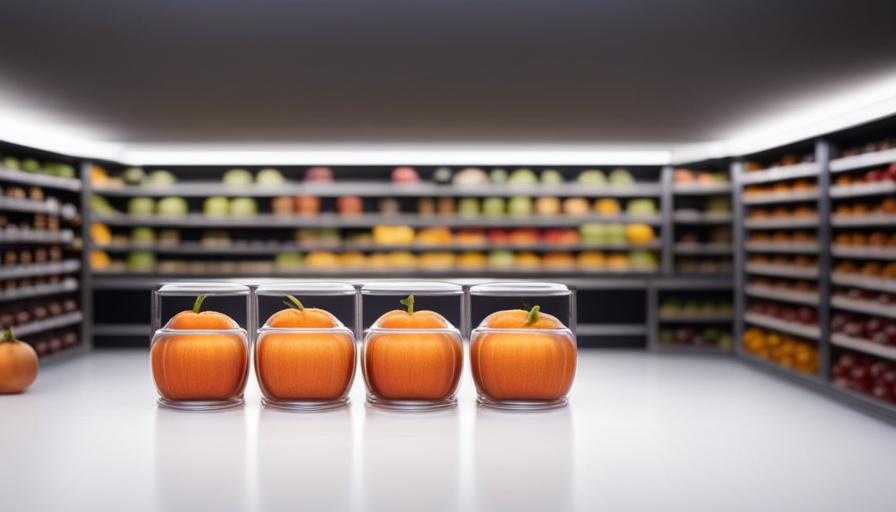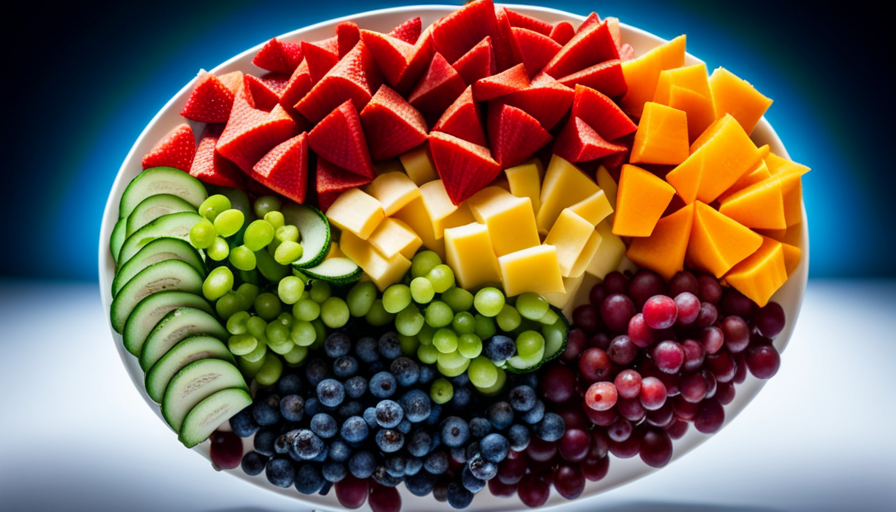If you’re interested in giving your furry companion a well-rounded diet, you might have thought about mixing frozen raw food and kibble. This unique method lets you offer the nutritional advantages of raw food while also enjoying the ease and affordability of kibble.
By blending these two feeding methods, you can ensure that your pet receives a balanced and nutritious diet that meets their specific needs. In this article, we will guide you through the process of feeding frozen raw food and kibble together, from understanding the benefits to troubleshooting common issues.
With our practical tips and evidence-based advice, you’ll be able to confidently navigate this unique feeding technique and promote your pet’s overall health and well-being.
Key Takeaways
- Combining frozen raw food and kibble provides a balanced and nutritious diet for pets, supporting their overall health and well-being.
- The combination of frozen raw food and kibble can improve digestion, weight management, coat condition, and reduce allergies in pets.
- It is important to consult with a veterinarian before transitioning to a frozen raw food and kibble diet, as they can provide personalized guidance and ensure the proper balance of nutrients.
- Proper storage, handling, and preparation techniques are crucial to maintain freshness and prevent bacterial contamination when feeding frozen raw food and kibble together.
Understanding the Benefits of Frozen Raw Food and Kibble
You’re probably wondering why combining frozen raw food with kibble can be so beneficial for your pet’s health and overall well-being. Well, let’s start by looking at the benefits of raw food only.
Raw food diets for pets have gained popularity in recent years, and for good reason. Raw food is packed with natural nutrients, enzymes, and proteins that can support your pet’s immune system, promote a healthy coat, and improve digestion. It can also help with weight management and reduce the risk of certain health issues, such as allergies and dental problems.
On the other hand, kibble also has its own set of benefits. It is convenient, affordable, and easy to store. Kibble is often fortified with essential vitamins and minerals, making it a balanced option for your pet’s overall nutritional needs. It also helps to promote dental health by reducing tartar and plaque buildup.
Now, when you combine frozen raw food with kibble, you can provide your pet with the best of both worlds. The raw food provides the natural, nutrient-rich goodness, while the kibble adds convenience and balanced nutrition. This combination can help ensure that your pet receives all the necessary nutrients for optimal health and vitality.
Remember, it’s important to consult with your veterinarian before making any changes to your pet’s diet, especially if you’re considering introducing raw food. They can provide guidance based on your pet’s specific needs and help you create a balanced meal plan that incorporates both frozen raw food and kibble.
Ensuring a Balanced Diet for Your Pet
Hungry for ways to keep your pet’s diet perfectly balanced? Ensuring a balanced diet for your pet is crucial for their overall health and well-being. When feeding frozen raw food and kibble together, it’s important to make sure your furry friend is getting all the necessary nutrients.
Here are some tips to help you provide a well-rounded and balanced diet for your pet:
-
Variety is key: Offer a variety of proteins and vegetables to ensure your pet receives a wide range of nutrients. This can be achieved by rotating different flavors of frozen raw food and incorporating different types of kibble.
-
Consult your veterinarian: Your vet can provide valuable guidance on the specific nutritional needs of your pet. They can recommend the appropriate portion sizes and help you create a feeding schedule that suits your pet’s needs.
-
Supplement when necessary: Some pets may require additional supplements to meet their nutritional needs. Talk to your vet about adding supplements such as omega-3 fatty acids or joint supplements to support your pet’s health.
-
Monitor your pet’s weight: Regularly check your pet’s weight to ensure they are maintaining a healthy body condition. Adjust the amount of food accordingly to prevent under or overfeeding.
By following these tips and providing a balanced diet, you can ensure that your pet is receiving the necessary nutrients for optimal health and vitality. Remember, a healthy diet is the foundation for a happy and thriving pet!
Transitioning Your Pet to a Frozen Raw Food and Kibble Diet
When it comes to transitioning your pet to a diet combining frozen raw food and kibble, it’s important to take it slow and gradually introduce the new food options.
This transition process is crucial to prevent any digestive upset or discomfort for your furry friend. Start by mixing a small amount of frozen raw food with your pet’s regular kibble, gradually increasing the proportion of raw food over a period of 7-10 days. This allows your pet’s digestive system to adjust to the new diet.
There are several benefits to feeding a combination of frozen raw food and kibble. Raw food provides essential nutrients and enzymes that can improve digestion and boost overall health. It also helps maintain a healthy weight, promotes a shiny coat, and reduces the risk of allergies. On the other hand, kibble provides convenience and balanced nutrition. It contains essential vitamins and minerals that may be lacking in raw food alone. Combining the two ensures your pet receives the benefits of both.
However, there are some drawbacks to consider. Frozen raw food can be more expensive and requires proper handling to prevent bacterial contamination. Additionally, some pets may not tolerate the transition well and may experience gastrointestinal issues. It’s important to monitor your pet closely during the transition process and consult with your veterinarian if any concerns arise.
Transitioning your pet to a diet combining frozen raw food and kibble should be done gradually to avoid digestive issues. This combination offers the benefits of raw food’s nutrients and enzymes, as well as the convenience and balanced nutrition of kibble. However, it’s important to be aware of the potential drawbacks and consult with your veterinarian for guidance.
Managing Portion Sizes and Feeding Schedule
One important aspect of incorporating a frozen raw and kibble diet for your pet is managing their portion sizes and feeding schedule. It’s crucial to ensure that your furry friend is getting the right amount of food to maintain a healthy weight and receive the necessary nutrients.
When it comes to portion sizes, it’s essential to follow the guidelines provided by the manufacturer or consult with your veterinarian. These guidelines are typically based on your pet’s weight and activity level.
To establish a feeding routine, it’s recommended to feed your pet at the same times each day. This helps them develop a consistent eating pattern and prevents overeating. Divide their daily recommended portion into two or three meals, depending on their age and size. If your pet tends to eat too quickly, consider using puzzle feeders or slow-feed bowls to promote slower eating and prevent digestive issues.
It’s important to note that individual pets may have different needs, so it’s crucial to monitor their body condition and adjust portion sizes accordingly. Regularly assess their weight and consult with your veterinarian if you notice any changes.
By managing portion sizes and establishing a feeding routine, you can ensure that your pet is receiving a balanced diet and maintaining a healthy lifestyle.
Choosing High-Quality Frozen Raw Food and Kibble Brands
Savor the taste of a culinary masterpiece by selecting only the finest brands that blend the essence of nature’s bounty into every delectable morsel. When choosing affordable frozen raw food and kibble brands, it’s important to consider the quality of ingredients and the manufacturing processes used.
Look for brands that use high-quality, human-grade ingredients sourced from reputable suppliers. Avoid brands that use fillers, by-products, or artificial additives. Reading customer reviews and consulting with veterinarians can also help guide your decision.
Proper storage of frozen raw food and kibble is essential to maintain freshness and prevent bacterial growth. Keep frozen raw food in the freezer until you are ready to thaw and serve it. Store kibble in a cool, dry place, away from direct sunlight. It’s recommended to transfer kibble to an airtight container to preserve its freshness and prevent pests from getting into the bag.
When feeding a combination of frozen raw food and kibble, it’s important to introduce each gradually to prevent digestive upset. Start by mixing a small amount of the new food with the old food, gradually increasing the ratio over a week or two. Monitor your pet’s digestion and adjust the proportions as needed.
By choosing high-quality brands and properly storing frozen raw food and kibble, you can provide your pet with a balanced and nutritious diet that satisfies their taste buds and supports their overall health.
Mixing and Serving Frozen Raw Food and Kibble Together
Experience a culinary adventure by combining the delectable flavors of frozen raw food and kibble into a harmonious feast for your furry friend. Mixing frozen raw food and kibble together can provide a balanced diet that combines the benefits of both.
To ensure proper mixing, start by thawing the frozen raw food according to the manufacturer’s instructions. Once thawed, mix the raw food with the kibble in a ratio that suits your pet’s dietary needs. You can gradually increase the amount of raw food over time if you wish to transition your pet to a fully raw diet.
When it comes to storage, it’s important to handle both the frozen raw food and kibble properly. Keep the frozen raw food in the freezer until you’re ready to thaw and serve it. Store the kibble in an airtight container in a cool, dry place to maintain its freshness. To prevent cross-contamination, use separate utensils and bowls for the raw food and kibble.
Remember to monitor your pet’s reaction to the mixed diet and make any necessary adjustments. Some pets may have digestive sensitivities, so it’s always a good idea to consult with your veterinarian before introducing any new diet.
By following these mixing techniques and storage options, you can provide a culinary experience that satisfies your pet’s taste buds while nourishing them with a balanced diet.
Monitoring Your Pet’s Health and Well-being
Ensure your furry friend’s vitality and happiness by closely monitoring their overall health and well-being. Properly monitoring your pet’s health is crucial to ensure they’re getting the right nutrition and meeting their dietary needs. Here are four key things to keep an eye on:
-
Weight: Regularly check your pet’s weight to ensure they’re maintaining a healthy body condition. Sudden weight loss or gain can indicate a problem with their diet or overall health.
-
Energy levels: Observe your pet’s energy levels and activity levels. If they seem lethargic or have a sudden decrease in energy, it could be a sign of nutritional deficiencies or other health issues.
-
Coat condition: A pet’s coat can be a reflection of their overall health. A dull, dry, or flaky coat may indicate a lack of essential nutrients in their diet. On the other hand, a shiny and healthy coat usually indicates good nutrition.
-
Digestion: Monitor your pet’s digestion to ensure they’re able to properly digest and absorb nutrients from their food. Any changes in their bowel movements, such as diarrhea or constipation, could indicate an issue with their diet.
By keeping a close eye on these aspects of your pet’s health, you can make adjustments to their diet as needed and ensure they’re getting the proper nutrition to thrive. Remember to consult with your veterinarian for personalized advice on your pet’s specific dietary needs.
Introducing Variety in Your Pet’s Diet
To truly nourish your pet and keep their taste buds tantalized, it’s important to introduce a variety of flavors and textures into their diet.
Providing your pet with a varied diet has numerous benefits. Firstly, it prevents them from getting bored with their meals, ensuring they stay excited and engaged during mealtime. Secondly, different foods offer a range of nutrients, which helps to ensure your pet receives a well-rounded diet. By incorporating a variety of proteins, fruits, and vegetables, you can provide them with essential vitamins, minerals, and antioxidants.
When introducing variety into your pet’s diet, it’s important to consider their individual needs and preferences. Start by gradually introducing new foods alongside their regular meals, allowing them to adjust to the change. This gradual transition will help prevent any digestive issues or food aversions. Additionally, it’s important to monitor your pet’s response to the new foods. Keep an eye out for any signs of allergies or sensitivities, such as itching, vomiting, or diarrhea. If you notice any adverse reactions, consult your veterinarian for guidance.
Remember, variety is the spice of life, even for our furry friends. By introducing different flavors and textures into your pet’s diet, you can ensure they receive a well-balanced and exciting meal every time. So go ahead, mix it up and watch your pet’s tail wag with delight!
Consulting with a Veterinarian for Guidance
When seeking advice from a veterinarian, they can serve as a compass guiding you through the vast sea of pet nutrition, ensuring your furry companion sails towards optimal health. Consulting with a veterinarian is crucial when considering alternative feeding methods and homemade raw food options for your pet. They can provide you with evidence-based recommendations tailored to your pet’s specific needs.
To help you understand the benefits and potential risks of incorporating both frozen raw food and kibble into your pet’s diet, here is a table outlining the key considerations:
| Feeding Method | Benefits | Potential Risks |
|---|---|---|
| Frozen Raw Food | – High nutritional value | – Risk of bacterial contamination |
| – Improved digestion | – Potential nutrient imbalances | |
| Kibble | – Convenient and easy to store | – Lower moisture content can lead to dehydration |
| – Nutritionally balanced | – Lower quality ingredients may affect overall health |
It is important to note that each pet is unique, and consulting with a veterinarian will help determine the appropriate balance between these two feeding methods. They can guide you in choosing reputable brands, advise on proper storage and preparation techniques for homemade raw food, and monitor your pet’s health to ensure they are thriving on this combination diet.
Remember, always consult with a veterinarian before making any significant changes to your pet’s diet to ensure their safety and well-being.
Troubleshooting Common Issues and Concerns
Now that you’ve consulted with a veterinarian and have a better understanding of how to feed frozen raw food and kibble together, let’s discuss troubleshooting common issues and concerns that may arise during this process.
One common feeding issue is that your pet may refuse to eat the new diet. This can happen if they’re not used to the taste or texture of raw food. To overcome this, you can try gradually introducing the new diet by mixing small amounts with their regular kibble.
Additionally, some pets may experience digestive upset when transitioning to a new diet. If this happens, it’s best to slow down the transition process and give their digestive system time to adjust.
Another concern is the potential health risks associated with feeding raw food. Raw food diets have been linked to bacterial contamination, such as Salmonella or E. coli, which can pose a risk to both pets and humans. To minimize this risk, it’s important to handle raw food carefully, using separate utensils and surfaces, and practicing good hygiene. Freezing the raw food before feeding can also help reduce the risk of bacterial contamination.
By being aware of these common issues and taking necessary precautions, you can successfully feed frozen raw food and kibble together while ensuring the health and well-being of your furry friend.
Frequently Asked Questions
Can I mix frozen raw food and kibble together in the same bowl?
Yes, you can mix frozen raw food and kibble together in the same bowl. It can be beneficial to feed both types of food together as it provides a balanced diet for your pet. Mixing raw food with kibble allows your pet to benefit from the nutrients and enzymes in raw food while still getting the convenience and affordability of kibble. It’s important to consult with your veterinarian to ensure you’re meeting your pet’s specific dietary needs.
How should I adjust the portion sizes when feeding frozen raw food and kibble together?
To adjust portion sizes when feeding frozen raw food and kibble together, it’s important to consider the specific needs of your pet. Start by calculating the recommended portion size for each type of food separately. Then, divide the total daily portion into two meals. One meal is for frozen raw food, and the other is for kibble. Adjust the amounts based on your pet’s weight, activity level, and overall health. Feeding these two types of food together can provide a balanced diet with the benefits of raw nutrition and the convenience of kibble.
Are there any specific guidelines for serving frozen raw food and kibble to puppies or senior dogs?
When it comes to feeding frozen raw food and kibble together, there are some guidelines to consider for puppies and senior dogs. It’s generally safe to mix the two in the same bowl, but it’s important to consult with your veterinarian for specific portion sizes and ratios.
Puppies require a balanced diet with the right nutrients for growth, while senior dogs may have different dietary needs. Always monitor your dog’s health and adjust their diet accordingly.
Can I feed my cat a combination of frozen raw food and kibble?
Sure, you can feed your cat a combination of frozen raw food and kibble. It’s a great way to provide your feline friend with a balanced diet. While kibble offers convenience, frozen raw food has its benefits. It closely mimics a cat’s natural diet, promoting healthier digestion, shinier coats, and stronger immune systems. Just be sure to consult with your veterinarian and gradually transition your cat to this new diet to avoid any tummy troubles.
What are some common signs that my pet may not be tolerating the frozen raw food and kibble diet well?
Warning signs that your pet may not be tolerating a frozen raw food and kibble diet well can include gastrointestinal upset, such as vomiting, diarrhea, or excessive gas.
Other signs may include a lack of appetite, weight loss, or changes in behavior or energy levels.
These symptoms may indicate dietary sensitivities, which can vary from one animal to another.
If you notice any of these warning signs, it’s important to consult with your veterinarian for further guidance.
Can Frozen Raw Food and Kibble Be Mixed Together for Feeding?
Yes, freezing raw pear baby food can be a great alternative to store-bought options for your little one. However, it’s important to note that mixing frozen raw food with kibble for feeding pets may not be the best option as it can lead to digestive issues and potential bacterial growth.
Conclusion
Congratulations! You’ve successfully navigated the world of feeding frozen raw food and kibble together for your furry friend. By understanding the benefits and ensuring a balanced diet, you’ve taken a step towards their overall health and well-being.
Remember to manage portion sizes and choose high-quality brands to optimize their nutrition. Variety is key, so don’t be afraid to mix things up!
And if you ever have concerns, consult with a veterinarian for expert guidance. You’re now a pro at feeding your pet in the most paw-some way possible!










